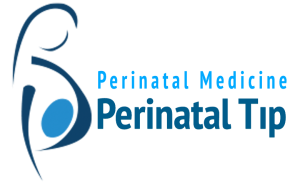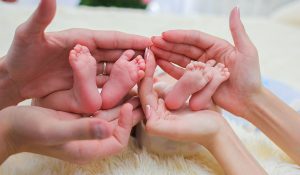
Monochorionic-Diamniotic (Identical Egg) Twins
 It occurs when the existing zygote mass splits into two between the 3rd and 8th days after fertilization occurs. Because the group of cells that will form the placenta is now differentiated, therefore the placenta will form as a single one. However, the cell groups that will form the amniotic membrane-sac and the fetus have not differentiated, so two separate fetuses and babies are formed as a result of this cell mass splitting into two.
It occurs when the existing zygote mass splits into two between the 3rd and 8th days after fertilization occurs. Because the group of cells that will form the placenta is now differentiated, therefore the placenta will form as a single one. However, the cell groups that will form the amniotic membrane-sac and the fetus have not differentiated, so two separate fetuses and babies are formed as a result of this cell mass splitting into two.
With a single formation of the placenta, the two babies share the same placenta. However, there are problems brought about by this sharing and development.
-The rate of miscarriage, premature birth, babies with anomalies has increased.
– Inability to develop heart-brain in a twin.
– Twin to Twin Transfusion Syndrome may develop.
– This type of twin pregnancy-specific growth retardation may develop due to both the shared placenta and the common vessel sharing.
– One of the babies may be lost in the womb. This situation may have its own unique problems with the other baby.
– If there is a separation in the cell mass between the 8th and 12th days, the cell groups that have formed the placenta and the amniotic membrane-sac until now cannot differentiate because they have differentiated, and the cell groups that will form the fetus have not differentiated, therefore, two separate fetuses as a result of the separation of this cell mass into two baby is formed. Two babies develop in the same sac. This situation results in losses in the womb in 50% of cases due to the entanglement of the umbilical cords and the formation of knots. These pregnancies are called MONOCHORIONIC-MONOAMNIOTIC TWIN PREGNANCY.
– If cell mass decomposition occurs late, after the 12th day, the cell groups that will form the fetus have begun to differentiate. With the separation of undifferentiated cell groups, whichever organ group it corresponds to, those organs become pairs. Cell groups that have already differentiated and developed to form tissues, whichever organ corresponds to them, become partners. This situation is called conjoined twins. There are some of the conjoined twins; Adhesion degrees can be determined while still in the mother’s womb. Therefore, it is possible to allow the continuation of pregnancy for those who can be separated after birth. However, in cases where the probability of successful separation surgery after delivery is very low, the pregnancy can be terminated.